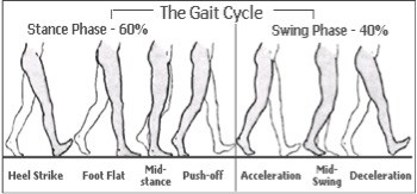Normal Walking
Normal gait and development
Motor Milestones
- 6-8 months: Sits with support. Concern if not sitting by 9 months.
- 9 months: Stands holding on.
- 10 months: Pulls to standing.
- 12 months: Walks with assistance. Concern if not walking by 18 months.
- 15 months: Walks unaided.
- 18 months: Runs.
- 2 years: Goes up and down stairs without assistance.
- 2.5 years: Jumps. Walks on tip-toes. Concern if cannot jump by school age.
- 3 years: Stands on one foot (few seconds). Goes up stairs 1 foot per step, comes down 2 feet per step.
- 4 years: Hops. Goes up and down stairs like an adult. Heel and tip-toe walk.
- 5 years: Skips.
- 7 years: Balance on one foot for 20 seconds.
Normal gait
- The normal child begins to walk at 12 to 14 months of age. Initially it is normal for the child to walk with a wide-based, externally rotated gait, taking numerous short steps. The gait then undergoes orderly stages of development.
- Walking velocity, step length and the duration of the single-limb stance increase with age and the number of steps taken per minute decreases.
- A mature gait pattern is well established by about 3 years of age, and the gait of a seven-year-old child resembles that of an adult.
- The normal adult gait cycle involves heel strike, stance and then toe-off. The stance phase is the foot in contact with the ground and the swing phase is the foot off the ground.

- There is considerable variation in the way normal gait patterns develop - such variation may be familial (e.g., ‘bottom-shufflers’ often walk later) and subject to racial variation (e.g., African black children tend to walk sooner and Asian children later than average).
- The normal toddler has a broad base gait for support, and appears to be high stepped and flat footed with arms outstretched for balance. The legs are externally rotated with a degree of bowing. Heel strike develops around 15–18 months with reciprocal arm swing.
- Running and change of direction occur after the age of 2 years, although this is often accompanied by frequent falls until the child acquires balance and coordination. In the school-age child, the step length increases and step frequency slows.
- Waddling gait is the typical gait of a 2 year old who is learning to walk. The feet are broad based in order to maintain balance, the child falls frequently. A waddling gait is abnormal in a child over the age of 3 years and if observed, it is important to look for other abnormal signs such as tip toe walking or protruding belly out (due to lumbar lordosis) in an attempt to maintain balance. These observations suggest proximal muscle weakness.

